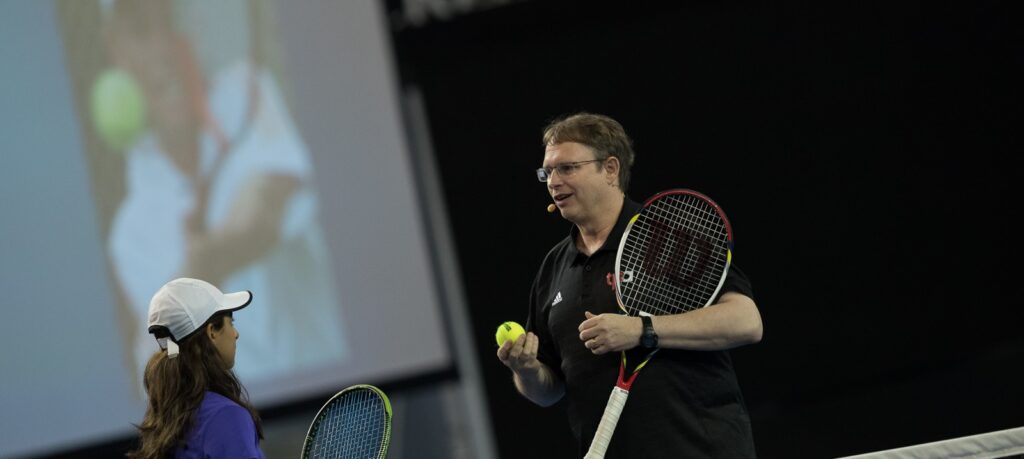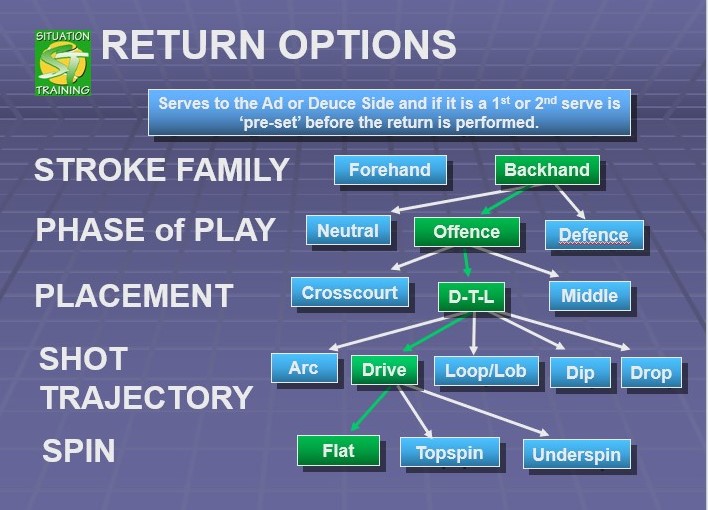

Photo credit: Front Row Studios -2017 Australian Open Grand Slam Coaches Conference
Situation Training (ST) is about helping players expand the library of situations they can handle during play by logically integrating tactics and technique.
In defining situations, ST uses two elements:
- ‘The 5 Point Situations’ are the general situations that occur during a point and include Serve, Return, Both-Back, Approaching and at Net, and Passing.
- ‘The Shot Cycle’: The elements that occur during a single shot situation (‘Shot’ for short)
(See acecoach.com article: ‘Situation Training–Core Elements’ for an introduction to these concepts) https://acecoach.com/situation-training-basic-elements/
This article will explore the Return Point Situation’s tactical categories and specific shots. The goal is to identify the most common shot situations that allow players to dominate when initiating the point with a return.
CRITICAL COMMON SITUATION
Analysis of game statistics reveals that over 70% of points end within the first four shots of a point. Every top coach I know agrees that the return is woefully under-trained. Apart from the serve, the return is the most common situation encountered in a match. Barring an ace or double fault, it happens every point.
Here are the tactical options available for the return:

The return is challenging since one can have a clear idea of what they want to do tactically; however, the strength of the serve can flip the choice to an emergency response.
BREAKING SERVE TACTICS
The end goal of a return strategy is to break serve. An effective breaking-serve strategy involves several pieces.
With the server typically having the advantage, the vital statistic becomes the percentage of 2nd serve points won. Arguably, at higher levels, the 2nd serve return is the critical hinge matches swing on as 2nd serves provide the most opportunity to take points. For most recreational players, match success is more a matter of ‘holding return’ than holding serve.
RETURNING TACTICAL OPTIONS
There are multiple options available on the return. Including:
- Taking the Return with the FH or BH
- Selecting the appropriate Phase of Play. Incorrectly determining if the return should be Neutral, Offensive, or Defensive is the root cause of many lost points.
- The intended placement of the shot (Crosscourt, Down-The-Line, Down the middle)
- The intended trajectory of the shot (An ‘Arc, ‘Drive’, Drop’ Loop/Lob’ or ‘Dip’)
- The intended spin for the tactic (‘Flat,’ ‘Topspin,’ ‘Underspin’) is selected to better control the trajectory and bounce of the ball.
RETURNING TACTICAL PACKAGES
We can combine options to create useful ‘Tactical Packages’ for training the most common return responses wrapped around the Phase of Play decisions.
1. OFFENSIVE RETURNS
Offensive returns are more common off 2nd serves but can be performed off any serve considered ‘weaker’. Once a weaker serve is identified, the returner must look to move inside the baseline to better their potential angles and take time away from the server. Using the offensive return as a set-up for the next shot (Return +1) is more effective than attempting an overly aggressive winner.
2. DEFENSIVE/NEUTRAL RETURNS
Stronger serves challenge timing, so selecting the appropriate Phase of Play is critical. Trying to do too much (over-risking) will lead to too many ‘free’ points. However, not doing enough sets the server up to dominate on their next shot. Balancing these is the key to a successful return.
PRACTICING
It works well to practice both serving and returning at the same time. For example, train to serve a slice ball wide and to return wide slice serves.
Because of all the reception as well as projection options possible, it is important in practice to prioritize the following:
- ‘Reading’ (Perception of the ball received) to make the best (and quickest) decision for a tactical response. Perception can be trained to be earlier and even lead to anticipation.
- Adapting the shot technically to respond in the most effective way.
CONCLUSION
Returning is an under-trained skill that can be improved to gain many points, especially since 70% of all points end within the first four shots. The end goal of returning is to put tactical packages together to break serve (or hold return as a recreational player). The key to training returns is ‘reading’ and adapting. Training the tactical options gives players the tools to perform under the pressure of the serve.
Leave a Reply